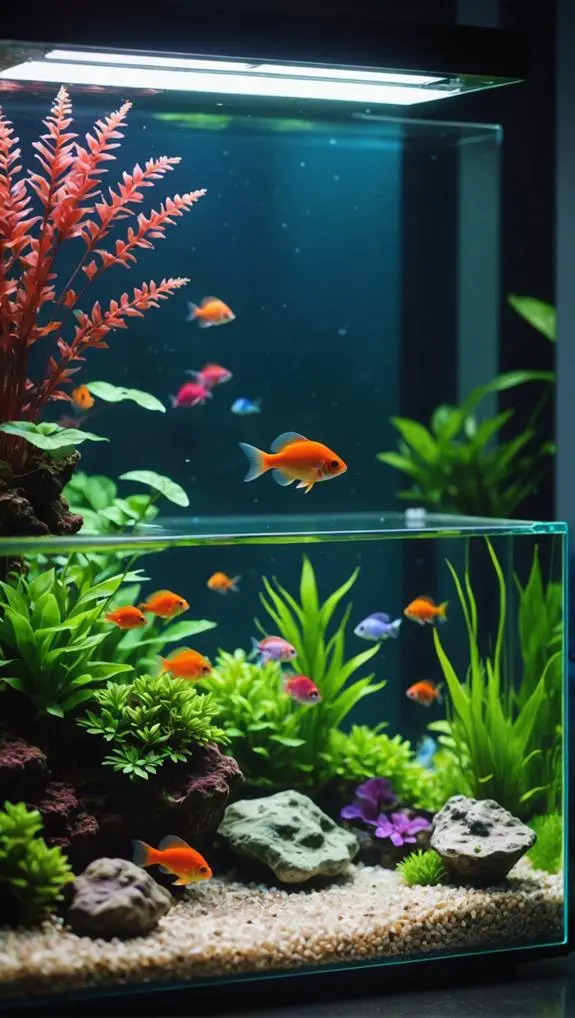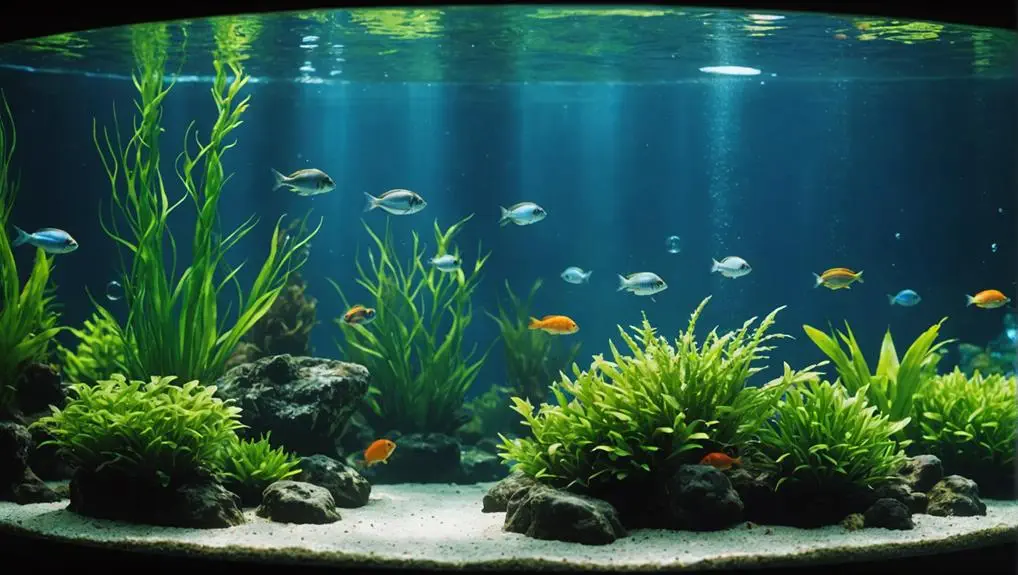Proper water parameters are vital for your fish's health, much like a balanced diet is for you! When factors like pH, temperature, and ammonia levels are off, your fish can get stressed or even sick. For instance, fish thrive at specific pH ranges and temperatures, and toxic ammonia levels can lead to serious health issues. Keeping a clean environment through regular water testing helps prevent problems before they arise. You wouldn't want your aquatic friends gasping for air or struggling to swim, right? Stick around, and you'll discover more tips to keep your tank thriving and your fish happy!
Contents
Essential Water Parameters Overview
When it comes to keeping fish healthy, understanding essential water parameters is crucial.
Think of your aquarium as a cozy home for your aquatic friends. To keep them happy, you need to pay attention to pH, temperature, hardness, and water quality. Most freshwater fish thrive in a pH range of 6.5 to 7.5.
Regular testing helps you avoid stress for your fish, which we all know is a big no-no!
Temperature is another key player. Tropical fish prefer a stable range of 76°F to 82°F. If the temperature swings too much, your fish might feel like they're on a rollercoaster!
Hardness, measured in parts per million (ppm), reflects the concentration of calcium and magnesium in the water. Aim for a general hardness (GH) between 40 to 500 ppm to keep your fish in top shape.
You also need to keep an eye on ammonia levels, which should be at 0 ppm. Elevated ammonia can create a toxic environment, turning your aquatic paradise into a nightmare.
Regular testing and maintenance of these parameters ensure your fish live a long and happy life!
The Nitrogen Cycle Explained
The nitrogen cycle is a vital process in your aquarium that ensures a healthy environment for your fish.
It starts with ammonia, a toxic byproduct from fish waste and uneaten food. Don't worry, though! Beneficial bacteria come to the rescue. They convert ammonia into nitrite, which is also toxic. But wait, there's more! These amazing bacteria then transform nitrite into nitrate, which is less harmful.
Now, even though nitrate is friendlier, it can still stress your fish if it gets too high—over 50 ppm is a no-go. That's why regular water changes are essential. By changing your water, you help keep nitrate levels down and maintain a stable environment.
In the first 4-6 weeks of setting up your aquarium, you'll see the nitrogen cycle start to establish, and that's when these beneficial bacteria really kick in.
Keep an eye on ammonia and nitrite levels, making sure they stay at 0 ppm. This way, you'll avoid any toxic surprises for your aquatic friends.
Understanding the nitrogen cycle not only keeps your fish happy but also gives you a sense of pride in creating a thriving underwater paradise!
Importance of Regular Water Testing

Maintaining a healthy aquarium goes beyond understanding the nitrogen cycle; regular water testing is a vital practice for keeping your fish safe and thriving. You wouldn't want to dive into a pool without checking the water first, right? Well, your aquatic friends deserve the same care! Testing water helps you catch early signs of ammonia and nitrite levels that can lead to toxic conditions threatening their health.
You should also monitor pH levels and hardness. Even small fluctuations can stress your fish, impacting their growth and immune function. Plus, keeping an eye on alkalinity prevents rapid pH changes, which can be deadly for your aquatic environment.
Don't forget about phosphate levels! Regular checks help you avoid harmful algae blooms that can deplete oxygen, turning your aquarium into an underwater nightmare. Establishing a routine water testing regimen lets you tailor conditions to meet your fish's specific needs.
This promotes their long-term health and vitality, making your aquarium a thriving ecosystem. So, grab those test kits, and give your fish the best chance at a happy, healthy life!
Understanding Ph Levels
When it comes to keeping your fish happy and healthy, understanding pH levels is super important.
You see, pH can really impact your fish's well-being, making it crucial to find that sweet spot for their specific needs.
If you ever need to adjust the pH, don't worry—there are simple ways to do it, and your fish will thank you with their little fishy smiles!
Ph Impact on Fish
Understanding pH levels is essential for ensuring the health of your fish. You might think of pH as a balance beam—too much on one side and your fish could be teetering on the edge. Most freshwater tropical fish thrive best in a pH range of 6.5 to 7.5. If you stray too far from this range, you could be inviting stress and health issues for your aquatic friends.
Rapid changes in pH can be like throwing your fish into a roller coaster ride—definitely not fun! Regular water changes help maintain stability, keeping your fish happy and healthy. And don't forget about ammonia; if your pH creeps above 7.5, ammonia toxicity can spike. That's a serious concern, as even a hint of ammonia can be harmful, or worse, fatal.
To keep an eye on things, grab some testing kits. Regular checks are key to ensuring the pH stays within a safe range. After all, when it comes to fish health, a little prevention goes a long way.
Adjusting Ph Levels
To keep your fish thriving, adjusting pH levels is crucial. pH measures how acidic or basic your water is, and for most freshwater aquarium fish, a neutral pH of 7 is ideal. However, some species have different needs. Tropical fish usually prefer a pH between 6.5 and 7.5, while African cichlids like it a bit higher, around 7.8 to 8.5. So, knowing your fish's preferences can make a big difference!
Regular testing is essential because even tiny fluctuations can stress your fish and lead to health issues.
When adjusting pH, be careful! Increasing it too quickly can raise ammonia toxicity, which isn't a fun time for your aquatic friends. You can stabilize pH levels through regular water changes and using buffer solutions designed for your fish species.
Think of it as giving your fish a cozy home instead of a bumpy ride. They deserve the best!
Managing Ammonia and Nitrite

When it comes to keeping your fish happy and healthy, managing ammonia and nitrite levels is a big deal.
You mightn't know it, but even tiny amounts of ammonia can stress your fish out, and nitrite can be downright toxic.
Ammonia Toxicity Symptoms
Ammonia toxicity can severely impact your fish's health, often showing distress through specific symptoms. If you notice your fish gasping at the water's surface, it's a clear sign that elevated ammonia levels are causing respiratory issues.
You might also see them swimming oddly or just hanging around lethargically. These behaviors indicate that your fish are struggling, and you should act quickly to protect their well-being.
Regular testing of ammonia and nitrite levels is crucial, especially in newly established aquariums. The nitrogen cycle can take time to stabilize, and during this period, your fish are at risk.
If you find ammonia levels above 0 ppm, consider doing partial water changes to help dilute that toxicity.
Nitrite Poisoning Effects
Nitrite poisoning can follow closely after ammonia toxicity, posing another serious threat to your fish's health.
When nitrite levels rise above 0 ppm, your fish may show signs like poor appetite, inactivity, and those infamous brown gills. While fish can handle up to 0.5 ppm for a short time, prolonged exposure can lead to severe stress and even suffocation. That's not a fun scenario for anyone!
To keep your aquatic buddies safe, regular testing aquariums is vital. You want to catch those nitrite spikes early, especially since they often happen when the nitrogen cycle gets disrupted and ammonia levels rise.
If you notice a nitrite issue, don't panic! You can perform water changes and even add a bit of aquarium-safe sea salt to help ease the situation.
Testing and Mitigation Strategies
Maintaining optimal water parameters is essential for your fish's health, and testing for ammonia and nitrite levels is a crucial part of that process. You want your aquatic friends to thrive, not just survive, right? Ammonia levels should be a big, fat 0 ppm because even small amounts can stress your fish. Nitrite, that sneaky little culprit, should also stay at 0 ppm; otherwise, your fish can suffocate.
To tackle those pesky levels, regular water changes of 25-50% are key. Think of it as a refreshing spa day for your fish! Adding sea salt (1-3 tsp/gal) can help mitigate toxicity too.
Plus, don't forget about your biological filter—it's like having a tiny team of superheroes turning toxic ammonia into nitrite and then to less harmful nitrate, keeping the nitrogen cycle in check.
Make water testing a habit, especially during the tank cycling process. If you spot spikes, it's time to act fast for the sake of your fish health.
Strategies for Algae Control
Algae can quickly become a nuisance in your aquarium, but implementing effective strategies can keep it in check. First off, aim for regular water changes of about 10-20% weekly. This helps dilute excess nutrients like nitrates and phosphates, which are prime suspects in promoting algae growth. You want to maintain those water parameters for optimal fish health!
Next, consider introducing algae-eating species, such as snails or Siamese algae eaters. These little helpers can naturally control algae populations, giving your fish a cleaner space to thrive.
Don't forget about lighting! Keeping your photoperiod to 8-10 hours a day can prevent excessive algae growth caused by too much light.
And let's not overlook phosphate-absorbing media for your filters; they're fantastic at reducing phosphate levels that lead to those pesky blooms.
Lastly, monitor your feeding practices. Overfeeding leads to waste buildup, which in turn fuels algae growth. So, keeping your fish happy and healthy also means keeping your aquarium clean!
With these strategies, you'll be well on your way to a beautiful, balanced aquarium.
Frequently Asked Questions
Why Is Water Quality Important for Fish?
Water quality's crucial for fish because it affects their behavior, oxygen levels, and pH balance. You'll avoid ammonia toxicity and nitrate effects by ensuring temperature stability and performing regular water changes for healthier aquatic life.
What Is the Most Important Parameter to Improve the Health of Your Fish Tank?
To improve your fish tank's health, focus on tank cycling, proper substrate selection, and temperature regulation. Also, ensure filtration efficiency, effective algae control, and disease prevention to create a harmonious environment for your tank mates.
What Are the Important Water Parameters in Aquarium?
You should monitor pH levels, nitrate concentration, and ammonia toxicity while ensuring proper hardness measurements, temperature stability, dissolved oxygen, and salinity control to create a thriving environment for your fish and serve their needs effectively.
How Important Is KH in an Aquarium?
KH levels are vital for your aquarium's buffering capacity, ensuring pH stability. They influence fish compatibility, help manage algae control, and meet freshwater needs. Use test kits regularly to maintain optimal conditions for thriving aquatic life.
Final Thoughts
In the world of fishkeeping, you've probably heard, "You are what you eat." Well, for fish, it's more like, "You are where you live." Keeping a close eye on water parameters is crucial for their health and happiness. Regular testing, managing ammonia, and controlling algae can make a big difference. So, dive into your aquarium care with confidence! A little effort goes a long way in creating a thriving underwater paradise for your finned friends.












